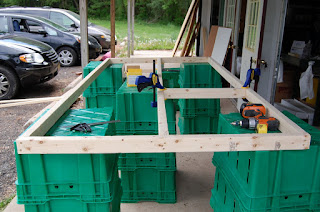In previous posts you've seen the seeding trays resting on 'tables'. While these tables do not need an architects expertise to design and build, they do need to get built. The following pictures will show how this is accomplished.
Step 1. First you need lumber. In this case the frame is made of 2x3 studs, 8 feet in length. The goal is to find pieces of wood that are as straight as possible. This is not as easy a task as you might imagine. For every piece of wood that was selected at least 5, if not more, were rejected. David is using 2x3's to make the tables lighter in weight. They are held together using deckmate screws. Clamps made screwing the pieces of wood together much simpler than using one's hands. Notice that produce crates make a great work table. Farmers are very resourceful at using what is at hand.

Step 2. After the outside frame has been assembled a 2x3 stud is connected to provide strength and support. Again, clamps are used to hold the wood in place as the screws are inserted. At the top of the photo you can see the clamp holding the wood in place. In the right front of the picture, on the produce crate you can also see the clamp.

Step 3. Again using 2x3 pieces of wood, support braces are screwed into place. The top picture shows one brace being put into place. The second picture shows all four braces in place. As with the center brace, the purpose of these braces is to provide stability and strength to the table as a whole.


Step 4. Additional support braces are placed the length of the table. For this step 1x2 pieces of wood were used. As with the 2x3's finding straight pieces of wood is important and was quite challenging. It took about ten pieces of wood to find one usable piece. These braces do not lend much to the overall stability of the table itself. It will provide support for the wire that will now be stapled onto the completed frame of the table. To assemble this frame takes approximately one hour.
 Step 5. Here is David using a staple gun to stable the wire onto frame of the table. At the top of the table is the roll of wire that is used. Chicken mesh wire is then stapled over this wire. This allows for a more stable surface on which to place the seeding flats. In the second photo you can see the completed table. It takes approximately 30 minutes to staple both pieces of wiring to the table.
Step 5. Here is David using a staple gun to stable the wire onto frame of the table. At the top of the table is the roll of wire that is used. Chicken mesh wire is then stapled over this wire. This allows for a more stable surface on which to place the seeding flats. In the second photo you can see the completed table. It takes approximately 30 minutes to staple both pieces of wiring to the table.

And there you have it. At this time there are currently 29 completed tables. Most of them will be place in the greenhouse. The rest will stay outside the greenhouse where plants will go to be 'conditioned' prior to going into the field. (More about this in a future post.)
The dog days of summer. Here Hule is resting under a tree escaping the oppressive summer heat. Oops! It is only the first week of May. Hmmm? What does that imply about how the summer weather is going to be?

Things are moving along at Z Food Farm but much work remains to be done. Stay tuned for ongoing updates. And don't forget to check out the website (www.zfoodfarm.com). The site is still in its developmental stages but should be up to date by the beginning of June. Until next time, peace and healthy eating to all.

No comments:
Post a Comment